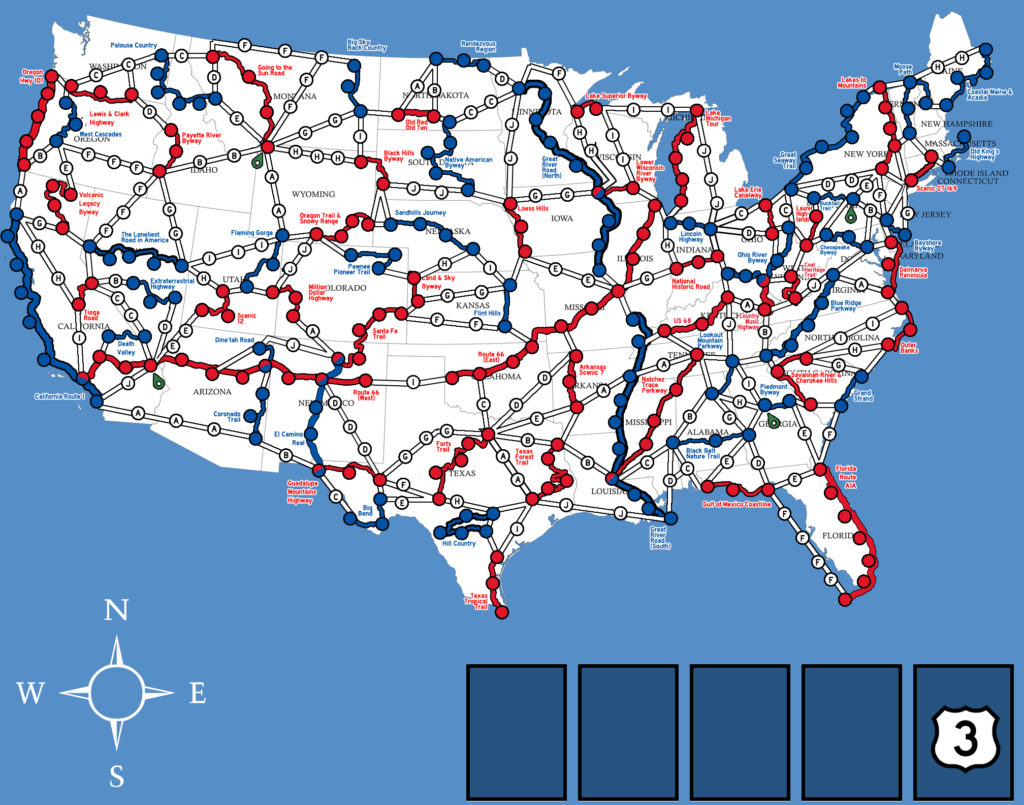How to Make Board Games for a New Audience
Dev Diary posts are made to teach game development through specific examples from my latest project: Highways & Byways. Just here for Highways & Byways updates? Click here.
One of the biggest challenges I’m facing right now with Highways & Byways is that the audience I’m courting is different from the audience I won with War Co. In fact, I’ve been thinking this week that in the absence of major game development or logistics challenges, this will be the defining challenge of this Kickstarter campaign. War Co. was an expandable card game about the sci-fi post-apocalypse. It was gritty, complex, and grim. Highways & Byways is a casual family board game set in a nostalgic vision of the United States of America. It’s hopeful, approachable, and exciting.

Looking for more resources to help you on your board game design journey?
Here you go: no email required!
Like this writing style?
Check out my latest blog on marketing here.
I did this on purpose. I was looking for a change after War Co. and wanted to court an entirely different audience. There are a lot of good reasons to chase a new audience: it could be a bigger market, or they could shore up a weakness in your portfolio of games for sale, or maybe you just simply want a change. For Highways & Byways, all three of these reasons are true.
There are many dangers with pursuing a different audience than the one you’ve pursued in the past, too. When you market to a new audience, that requires either a lot of time or a lot of money. Both represent a sacrifice, and you can only hope that it’s worth it to do so. You might also run the risk of confusing people about the direction you’re taking with your business, something I’ve encountered a couple of times.
You might expect me at this point to say “here are 5 ways you know you’re ready to change your audience.” If you’re a solo developer, it’s a deeply personal decision. If you work in a team or a larger business, this is something you will have to consider with the unique evidence in front of you.
What I will offer instead are five guidelines for reaching out to a new audience:
1. Make it clear you are making something different.
Reinventing yourself or your company is one of the most powerful things you can do to reset your strategy. It is also a great way of courting attention. The only trouble is that you have to be crystal clear about what you are doing when you are doing something totally different.
If people expect you to make heavyweight games, but you really want to make a family game, you have to be crystal clear about that. Make sure your marketing materials make it very clear what you are doing. Put it on the box, the Board Game Geek page, and the pitch emails to reviewers. Make sure your new audience and your new intentions are written everywhere you can write it and spoken about everywhere you can talk about it.
Clear communication builds trust. When you’re breaking from the norm and doing something totally new, you need to make people trust you. That makes clear communication extra critical.
2. Invest heavily in the new audience while keeping your current customer base.
If you have launched a successful project, as I have with War Co., it’s tempting to pitch your new idea to the same audience. Yet if your new idea is in a totally different niche, you’d be breaking a foundational rule of marketing. Every product has a different target market, and you need to seek that target market out. Don’t sell gas to people who don’t have cars.
Stay in touch with your current customers – they trusted you enough to buy your earlier game or games. They may buy your stuff because it’s you and not because of the game itself. This is significant, but it probably won’t be enough to meet your new product’s potential. That’s why you have to build another audience.
3. Reach out to new channels.
A great way to grow a new audience is to reach out to new channels. You can do this through passive means such as advertising or active means such as social media and conventions. You can also get on blogs, podcasts, and live-streams by helping other content creators out. Don’t confine yourself to the same people you’ve worked with in the past. Find new collaborators. You don’t even have to stick with people in the board game industry! Remember: not everyone who would be willing to play your game spends all day on Board Game Geek or /r/boardgames.
4. Use your reputation to your advantage.
When you make a new product, many people won’t know who you are. They can find out quickly, though, and if they see you’ve already successfully launched a project in the past, that will help you. If you have a reputation for making good games, fulfilling on-time, helping others, or having great customer service, then use that reputation to your advantage. Play it up. Make sure it’s prominently stated or at least implied in your marketing materials. People who don’t know you can still come to trust you through the “social proof” provided by people who trusted you before.
5. Understand there will be misunderstandings.
Despite all your best efforts, some of your old customer base will be confused by what you’re doing with your new game. I’ve had people expecting me to make another rules-heavy game of sabotage-based mechanics like I did with War Co. I didn’t want to do that with Highways & Byways, and despite my best efforts, some people still had the impression that Brandon = War Co.
If you change up your style, people will still associate you with your old ways. McDonald’s has stepped up their game with coffee and nicer locations, but people still think of it as being a pretty bad fast food restaurant. The Beastie Boys never totally shook their party boy reputation even after they released the seamy, dark, weird, eclectic Paul’s Boutique. And at the root of every movie with a hero seeking redemption for awful deeds long since past, you can see this truism at work.
The only responses I have are simple. Be persistent in pursuit of your new idea. Be patient with others who can’t keep up with your every move. Be consistent in your communication. Over time, you’ll be able to reinvent yourself 🙂
Most Important Highways & Byways Updates
- Reviews for Highways & Byways are starting to come in, such as this positive and descriptive one from Pawn’s Perspective.
- Highways & Byways has a Board Game Geek page now!
- I’m still working on getting on blogs, podcasts, and streams. I’ve worked with a lot of cool people, it’s a real privilege 🙂
- I’m starting to get printing samples in – I want to nail down a first-choice and second-choice printer before the campaign so my pricing estimates are super accurate.







